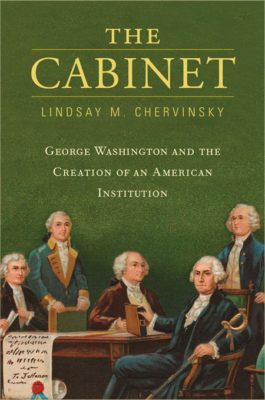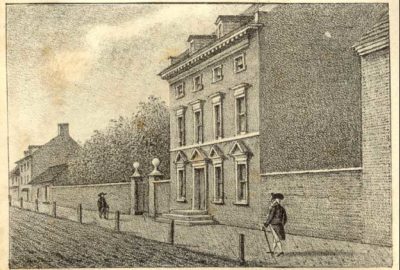Editor's Note
Lindsay M. Chervinsky, Ph.D., is a historian at the White House Historical Association. Her book, The Cabinet: George Washington and the Creation of an American Institution will be published by Harvard University Press on April 7, 2020. Follow her on Twitter: @lmchervinsky.
 I’ve always been fascinated by how individuals can influence policy, government, and events. At no time did a small group of people have more power over the development of government and events than in the 1790s when there were five people in the cabinet. Sure there are plenty of books on Jefferson, Hamilton, and their tempestuous relationship, but I wanted to know where the institution came from. It’s not in the Constitution, no additional legislation created the body, and everything I read seemed to assume the cabinet’s existence as inevitable.
I’ve always been fascinated by how individuals can influence policy, government, and events. At no time did a small group of people have more power over the development of government and events than in the 1790s when there were five people in the cabinet. Sure there are plenty of books on Jefferson, Hamilton, and their tempestuous relationship, but I wanted to know where the institution came from. It’s not in the Constitution, no additional legislation created the body, and everything I read seemed to assume the cabinet’s existence as inevitable.
When I decided to tackle this question, I spent some time exploring the governors’ councils in the state governments, the British cabinet, and the councils of war in the Continental Army during the Revolution. But there was no avoiding that I really had to get into the minds of Washington and the department secretaries in order to understand their interactions and the development of the institution. While I didn’t really realize it at the time (after all, writing a dissertation and then your first book is very much the process of learning how to do those things), I followed a six step process:
One: I read a ton of biographies. I wanted to know what other authors had written about their personalities, what evidence they were using to back up their arguments, and how these books were similar or different. Plus, when I actually started digging into the archival material, I already had a sense of the narrative arc and that really helped me keep my facts straight.
Two: I searched the letters of Secretary of the Treasury Alexander Hamilton, Secretary of State Thomas Jefferson, and President George Washington to find any mention of a cabinet meeting. I quickly learned that Washington refused to use the word cabinet during his presidency and instead referred to them as “the gentlemen of my family” or “the secretaries.” By documenting when the cabinet met, I could determine patterns, moments of crisis, and when gatherings subsided.
Three: I tracked down remaining letters from the other secretaries to make sure I wasn’t missing any meetings on my master list.
Four: I dug into the correspondence and notes to try and get a sense of the character of the meetings. Thankfully, Hamilton and Jefferson kept copious notes about the cabinet meetings and Washington’s letters sometimes hint at discomfort or unpleasantness. For example, Washington would sometimes invite the secretaries to join him for a family dinner after a meeting. He didn’t say why, but we know it wasn’t because Hamilton and Jefferson were the best of pals. I began to hypothesize that Washington held these dinners to try and smooth over hurt feelings and build an esprit de corps among the secretaries—much like had done during the war with his officers.

William L. Breton, “Residence of Washington in High Street, Philada.”
One really important part of this process was comparing the notes. Hamilton would often write a quick outline of the meeting’s progress and then include notes about what he wanted to say or the speech he wanted to give. In Jefferson’s notes, however, he would write, “Hamilton made a jury speech of three-quarters of an hour, as inflammatory and declamatory as if he had been speaking to a jury.” The next day, Jefferson picked up where he left off: “Met again. Hamilton spoke again three-quarters of an hour.”[1] While Jefferson doesn’t say what he felt about Hamilton’s lengthy addresses, you can just feel
the frustration. Especially if you know that they are meeting in a small, cramped room, with no air conditioning, in the middle of the summer.
Five: Once I started to speculate about how they might have felt about each other, the room where they were meeting, and more, I explored social customs and conventions at the time. I looked into how they dressed, how they might have postured themselves, expectations of privacy, etc. I’m a big believer that you should start a new project exploring the historiography, but then you often have to return to it again once you have your evidence and further consider how the little details fit in larger social, economic, military, and religious norms. These details didn’t change my argument, but they added greater weight and dimension to my idea that Jefferson came from a fundamentally diplomatic background, while Hamilton was shaped by his military experience. They represented different versions of republican virtue and masculinity—indicated by their style of clothing and presentation—that clashed when confined in the cabinet.
Six: I’ve made this process sound super mathematical until this point, and it’s true that I tried to be really methodical about my approach to finding and documenting cabinet meetings. But history isn’t math and there isn’t always an equation. I found that I got to a point where I felt like I knew them. I trusted myself to fill in some of the fuzzy details. I try and be very clear about what I know for sure based on evidence and what I don’t, but I’m not afraid to share what I think might have happened.
I took this leap of faith when writing about Secretary of State Edmund Randolph’s resignation after the other secretaries had accused him of selling state secrets to France. Their correspondence is fairly well documented and Randolph wrote a pamphlet defending his actions, but none of the players ever wrote about their emotions. Leaning on what I knew about honor culture (mostly from Joanne Freeman), Washington’s sensitivity to scandal and desire to retire, and the written material, I tried to imagine myself in their positions. We know Washington felt betrayed by Jefferson’s political activities, he was exhausted by the presidency, and hated the criticism. Maybe he thought another one of his close advisors had stabbed him in the back? Randolph, on the other hand, had devoted decades to serving Washington, first as his private lawyer, then as his Attorney General, and finally as Secretary of State. What did Randolph feel as he waited across the hall for almost an hour after the initial confrontation? I probably would have paced across the floor and my mind would have raced as I tried to recall the conversations I had the year before. That seems like a normal human response. He must have felt outraged that Washington wouldn’t give him the benefit of the doubt and wounded that the other, lower-ranked secretaries, had the opportunity to question him. I was very explicit about what they actually wrote and what they might have felt, but writing that section was one of the most rewarding and enjoyable.
By the time I wrote the section about Randolph, which was one of the final parts of the book, I felt I had mastered the material as much as one can ever really understand events that came before our time. It was exciting and important to me that I share that knowledge with others. It might have been easier to just say “here’s what happened, here’s what they wrote.” But I think that’s far less interesting and tells an incomplete story. The whole point of writing a book is to share information with people they couldn’t get themselves through a cursory Google search, so why not have some fun with it.
[1] Thomas Jefferson, The Complete Anas of Thomas Jefferson
, ed. Franklin B. Sawvel. (New York: Round Table Press, 1903), 150-57.

0